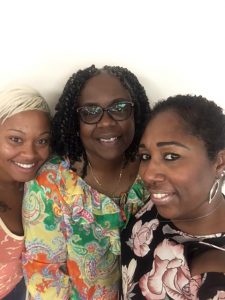In 2014, we made a shocking discovery. While analyzing the data for women who came to our hospital for breast cancer treatment between 2006 and 2011, we found that nearly 22 percent of them had stage 3 or 4 breast cancers—nearly double the national average of 10.5 percent.
Most of these women were African-American, and 54 percent of them lived in the District of Columbia. And of these D.C. residents, 40 percent of them lived in Ward 5, our hospital’s neighborhood. But what baffled us the most was that 97 percent of the Ward 5 patients with advanced breast cancer had health insurance.
This was especially surprising to me because of my work at the Cancer Preventorium, where we see people who have no symptoms for regular physical exams and cancer screenings such as mammograms. About 95 percent of the patients I see are Latino, most of whom are poor and without health insurance. They pay out of pocket for these preventive health visits, but do so because they know how important these screenings are.
So why were so many women who had access to preventive healthcare being diagnosed with advanced breast cancer? With help from a generous grant from the Avon Foundation for Women, we started the Get2Breast CARE (Cancer Awareness & Resource Education in Ward 5) program to find out why and to design an intervention to reverse the trend. In September 2017, we published the results of what we’ve learned so far.
Phase 1: What’s keeping women from getting mammograms?
Before we could do anything, we needed to find out why our female neighbors weren’t getting mammograms, the first line of defense against breast cancer. We sent community navigators out to survey 1,092 women in Ward 5.
The reasons we discovered included:
- Fear: Twenty-seven percent of women were afraid of a possible breast cancer diagnosis and the accompanying side effects and costs of treatment.
- Personal factors: Twenty-eight percent reported that they were too busy taking care of other family members or couldn’t take time off work to get a mammogram.
- Lack of education: Thirteen percent didn’t understand breast cancer risk factors, didn’t know when they should start getting a mammogram or that they needed them at all, or were unaware that their health insurance would cover them.
- Access: Seventeen percent said they would be more likely to get a mammogram if it were more convenient, such as being able to go before or after work, on weekends, or if screening was available closer to home.
- Mammogram misconceptions: The remaining reasons included myths, such as getting a mammogram is painful or that radiation from a mammograms actually could cause cancer.
Phase 2: Getting the word out about mammograms
Now that we were armed with the knowledge of why women weren’t getting mammograms, we developed educational materials based on that information. And our community navigators headed back out to coordinate outreach activities in the neighborhood. These materials and events focused on dispelling fear and empowering women to overcome personal barriers to receive potentially lifesaving mammograms.

Our amazing community navigators didn’t all have healthcare backgrounds, but they did have a passion to educate and a deep understanding and insider knowledge of the neighborhood. They knew the best places to reach their female neighbors, such as local businesses, churches and community centers. They also knew who they needed to talk to in order to make the event as successful as possible. For example, if they wanted to reach women from a certain church’s congregation, they knew to talk to the pastor’s wife, not the pastor.
There’s been some confusion in past years about when and who should get a mammogram. This is due to conflicting guidelines from various health organizations. We urged women in our outreach efforts to follow their doctor’s recommendations based on their unique risk factors. We also shared the American Cancer Society guidelines, which say women at average risk of breast cancer can begin having yearly mammograms at age 40 if they choose, but definitely should begin having them by age 45. At age 55, they can start having mammograms every other year.
Avon Get2Breast Care Community Navigators (left to right)
Janel Diaz, Lynel S. McFadden and Volunteer Community Navigator Sybil L. Smith
The community navigators gave a short survey before and after every educational event to ensure that women were getting the message. We found a 15 percent increase in the participants who believed that “a mammogram is the safest and most effective test available for finding early breast cancer.” Along with the educational events, we offered to schedule mammograms and to help navigate the process if the test yielded suspicious findings.
What’s next: Expanding the program across the city and including other cancers
I’ve seen firsthand the effect education and awareness can have on cancer prevention. I’ve been privileged since 1989 to host a daily one-hour radio broadcast called “El Consultorio Comunitario” (“The Community Clinic of the Air”), which gives disease prevention and health promotion messages on D.C.-area Spanish-language station Radio America WACA 1540AM, Monday through Friday, and via the Internet. The wide reach of this program likely plays a big role in why we see so many of our Latino neighbors at the Cancer Preventorium, despite the fact they may need to pay two-days’ worth of salary for the exam and screening.
The success of our intervention program in Ward 5 left us wanting to expand it further into the city. The Avon Foundation for Women stepped up again, helping to extend the experience to women in Wards 7 and 8. Nearly 70 percent of all women treated with breast cancer at our hospital come from the three wards in which we’re now working. We’re also excited to be talking with the Department of Health in D.C. about adopting our approach and taking it city-wide. And after finding the same disparity (insured people with advanced colorectal cancer) we started a similar approach to tackle colorectal cancer from the neighborhood.
We hope, through these intervention efforts, to see fewer women in D.C. diagnosed with advanced breast cancer in the future. Instead, we want to see more women for regular mammograms to detect breast cancer early, when the disease is easier to treat.

